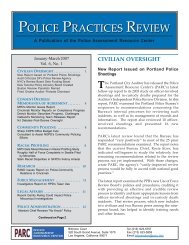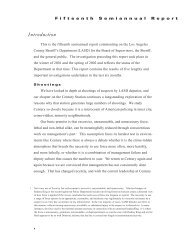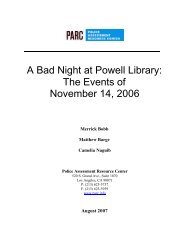July - Police Assessment Resource Center
July - Police Assessment Resource Center
July - Police Assessment Resource Center
You also want an ePaper? Increase the reach of your titles
YUMPU automatically turns print PDFs into web optimized ePapers that Google loves.
VOL. 2, Issue 7 <strong>July</strong> 2003<br />
SC: Yes, many CIT programs have their<br />
CIT officers equipped with additional<br />
less-lethal equipment. Examples of some<br />
of the most common less-lethal<br />
equipment are: impact weapons that<br />
shoot hard plastic, hard rubber, or<br />
another projectile; tasers that deliver<br />
shock energy by means of a battery<br />
power source; nets – though very<br />
difficult to use; and different kinds of<br />
chemical agents.<br />
PARC: How does the present CIT<br />
program differ from the original version<br />
that was established in 1988?<br />
SC: In 1988, CIT was founded with the<br />
hopeful expectation of bringing safety to<br />
officers, family members, and<br />
consumers. This was achieved, and since<br />
then CIT has become a specialized first<br />
crisis responder model.<br />
We have come along way in learning<br />
more about mental illness issues. This<br />
learning process is integrated within the<br />
context of seeing and understanding the<br />
human side of mental illnesses. The<br />
training process is very much about<br />
people – those who struggle and cope<br />
with their illness.<br />
Another remarkable change occurred<br />
within the department. Officers have<br />
stated that the status derived from being<br />
a CIT officer changed their life – CIT<br />
officers are very committed advocates<br />
for consumers and families, and speak<br />
out on local issues concerning<br />
appropriate community services. I am<br />
not sure you can say that the CIT<br />
program of 1988 is that much different<br />
from today’s version. I believe that the<br />
CIT model has matured, but has<br />
maintained a tradition.<br />
PARC: What effects, benefits, and<br />
achievements have resulted since the<br />
inception of the CIT program?<br />
SC: The CIT Program helped to identify<br />
the lack of mental health services within<br />
our community. The CIT program also<br />
helped identify other pressing<br />
community needs. One of our most<br />
important objectives was to establish a<br />
detoxification (detox) program. It took<br />
several years, but with a community<br />
effort we were able to accomplish this<br />
task. Prior to the establishment of our<br />
detox program, intoxicated individuals<br />
were arrested on a criminal public<br />
intoxication charge. Now officers are<br />
able to transport an intoxicated<br />
individual to the detox center. Many<br />
times when an individual is coming off<br />
of alcohol or drugs, it will be discovered<br />
that mental illness issues are also<br />
present.<br />
PARC: How many other jurisdictions<br />
have adopted a CIT Model?<br />
SC: My best guess is that somewhere<br />
between 50 and 80 departments have<br />
established a similar program throughout<br />
the country.<br />
PARC: What national trends have you<br />
observed, or do you foresee, regarding<br />
law enforcement’s interaction and<br />
handling of mentally ill suspects?<br />
SC: The American public is realizing<br />
that people who have a mental illness<br />
and/or substance abuse issues are<br />
disproportionately represented in<br />
correctional facilities across our country.<br />
People are realizing that individuals with<br />
mental illness are often inappropriately<br />
placed into the criminal justice system,<br />
and many times, it is due to a lack of<br />
<strong>Police</strong> <strong>Assessment</strong> <strong>Resource</strong> <strong>Center</strong> 213-623-5757 www.parc.info 12
















